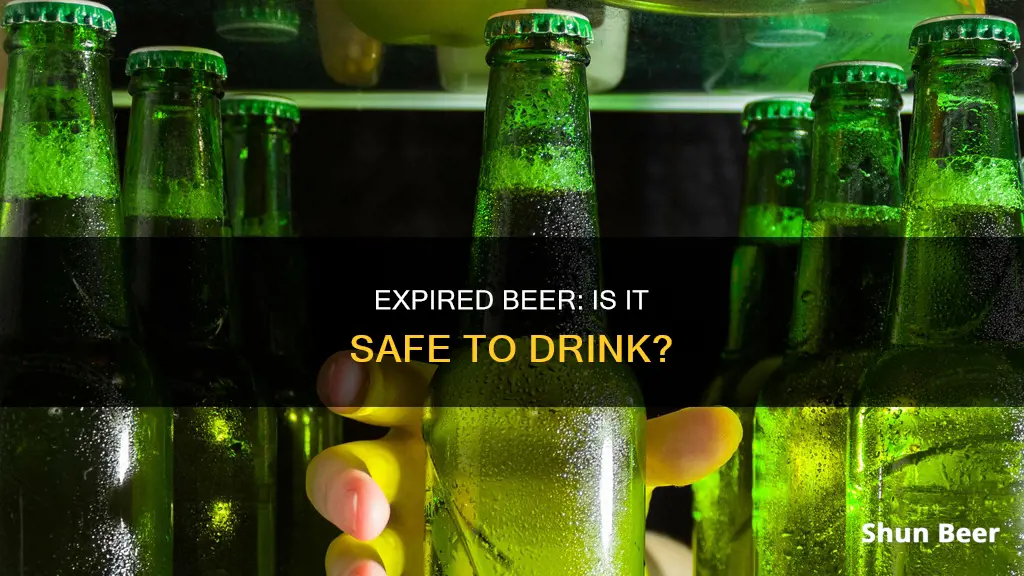
Drinking out-of-date beer is generally considered safe, but it might not taste very nice. Beers usually have a ''best before' date, which is more of a guideline on quality than a safety warning. Beer doesn't expire in the same way that milk does, and the alcohol and hops in beer prevent pathogenic growth. However, the longer beer is stored, the more its flavour will change. Oxidation, heat, and light can all cause flavours to go awry, and the volatile aromas of hops can dissipate over time.
| Characteristics | Values |
|---|---|
| Safety | Drinking beer past its expiration date is safe, but it may not taste as good. |
| Expiry Dates | Beer has a "best before" date, which is a guideline on quality rather than safety. |
| Beer Types | Beers with higher ABV, such as porters and stouts, can improve with age. IPAs, on the other hand, lose their flavour and aroma over time. |
| Storage | Beer should be stored in a cool, dark place, preferably in the refrigerator or a basement/cellar. |
| Identifying Bad Beer | Bad beer may have a bad aroma, lack carbonation, or have excessive sediment. |
What You'll Learn

Drinking out-of-date beer won't make you sick, but it might taste bad
The fermentation process used in brewing, as well as its low pH level and alcohol content, make beer an unfriendly environment for microorganisms. This means that even if a beer sits on the shelf for years, as long as it's sealed, it's unlikely to make you sick. However, if the seal has been broken, the beer will lose its fizz and its flavour will be compromised.
The main factors that can cause beer to spoil are light, oxygen, and heat. Hops are sensitive to UV radiation, so exposure to sunlight can cause a chemical reaction that produces a compound with a distinct skunky flavour. Oxidation can also cause the bright, malty flavours of some beers to turn into acidic flavours of stewed tomatoes with a cardboard-like aftertaste. High heat can also make beer go stale.
To keep beer fresh, it's important to store it in a cool, dark place, preferably the refrigerator. If storing at room temperature, keep it out of direct sunlight. It's also best to store bottles and cans upright to minimise exposure to oxygen.
Drinking Beer in an Uber: What You Need to Know
You may want to see also

Beer doesn't expire like milk does
However, beer can go bad in several ways. When beer comes into contact with oxygen during the brewing process, packaging, or storage, it oxidises. This means that the oxygen reacts with the beer's chemical makeup, breaking down hop oils and other flavour compounds. The beer's aroma will be reduced, and it will lose its fresh, inviting scents. Some beers may also darken as a result of oxidation.
Beer in clear or green bottles can become "skunky" when exposed to UV light due to a photochemical reaction between the UV light and the hop compounds in the beer. The beer will develop a distinctive sulfur-like smell reminiscent of skunk spray, and this will be accompanied by a corresponding off-flavour like sulfur.
Commercial beers are well-pasteurised and filtered, but improper brewing practices, packaging errors, or poor storage conditions can lead to bacterial contamination. Unintended wild yeast infestations can also contaminate beer, especially in home brews or improperly sealed commercial brews. Contaminated beer can taste sour, musty, or metallic, and it may become cloudy or develop unexpected sediment.
High temperatures accelerate chemical reactions, which break down the delicate flavour compounds. On the other hand, freezing can cause the beer to expand, potentially breaking the container and introducing oxygen upon thawing. Heat can cause beer to taste stale or cooked, while freezing can result in off-flavours. Temperature fluctuations can also affect the beer's carbonation, leading to flat or overly fizzy beer.
Over time, all beer will undergo chemical changes that alter its flavour, aroma, and mouthfeel. Aging causes the aromas and hop flavours to mellow, and the malt flavour becomes stronger. This is desirable for some people, but for others, it can mean a loss of the beer's intended profile. Older beer may develop a hazy appearance or unexpected sedimentation.
Beer Distribution in Georgia: A Complex System Explained
You may want to see also

Beer should be stored in a cool, dark place
Light
Beer is often stored in dark bottles to protect the liquid from the sun's UV rays. Exposure to sunlight creates a chemical reaction in the beer, breaking down its flavour components until the beverage smells and tastes like skunk spray. Beer that has been exposed to sunlight for too long is said to have been "skunked" or "lightstruck".
Heat
Heat accelerates the chemical reaction that breaks down the flavour components of beer. This is why it's best to store beer in a cool place. Fluctuations in temperature are not ideal for beer, but they are also not disastrous. It is generally fine to re-chill a beer that has been previously refrigerated. However, freezing beer is not recommended as this can cause haze and affect the texture and mouthfeel of the beer.
Oxidation
Oxidation is where oxygen affects the beer. Heat and motion accelerate the oxidative process. It is recommended that bottles are stored upright to limit the amount of beer exposed to oxygen.
Germans and Beer: A Cultural Relationship
You may want to see also

Beer is best consumed fresh
Hoppy beers, in particular, lose a lot of their aroma over time and are best drunk sooner rather than later. Beers like IPAs and Pale Ales are meant to be enjoyed fresh. The bright, vivid flavours of fresh beer are what get beer enthusiasts excited. The difference in taste between a fresh beer and an old one is clear.
Some beers, like people, can improve with age. Richer and higher ABV varieties of beer such as porters and stouts can get better with age, especially if they are kept in cool, dark storage conditions like a basement or cellar. However, these are the exception rather than the rule.
To ensure you are drinking fresh beer, always look for "bottled-on" dates printed on the label or bottle. A good rule of thumb is that beer will taste best in its first 30 days in a bottle. If the label shows that the beer has been in the bottle for more than 90 days, it is best to avoid it. Beers in cans tend to stay fresh-tasting longer than those in bottles, as cans block out sunlight and prevent oxygenation better.
When buying beer, be picky. If you check dates and only buy from cold boxes, your chances for deliciousness greatly improve.
Beer and Yeast Infections: Is There a Link?
You may want to see also

Beer is unlikely to make you sick due to its fermentation process, low pH, and alcohol content
Beer typically has a "best before" date, which is a guideline on quality rather than safety. Even if a beer sits on the shelf for years, as long as it's sealed, it's unlikely to make you sick. The fermentation process used in brewing, as well as its low pH and alcohol content, make beer an unfriendly environment for microorganisms.
However, it's important to note that the taste of beer can change over time. While some beers can improve with age, like porters and stouts, others, such as IPAs, gradually lose their flavour and aroma. The flavour changes are due to the organisms used in the brewing process. Yeasts used to produce flavours in speciality beers can change the flavour over time, living in the beer for years and consuming sugar and oxygen to ferment its ingredients.
Additionally, certain storage conditions can impact the quality of beer. It's recommended to keep beer in a cool, dark place, preferably refrigerated, to minimise the effects of oxygen, heat, and light, which can cause flavour deterioration.
While outdated beer is unlikely to make you sick, it's important to inspect the beer for any signs of spoilage before consumption. If the beer has lost its fizz or has developed a vinegary taste, it's best to discard it.
Beer: A Singer's Remedy or Vocal Cord Myth?
You may want to see also
Frequently asked questions
Drinking out-of-date beer will not make you sick or hurt you in any way. The worst thing that will happen is that the beer will taste bad.
A bad aroma, lack of fizz, and a vinegary taste are all signs that a beer has gone bad.
Beer has a long timespan and this differs depending on the type of beer. A typical lager will be drinkable 6-24 months after its best-before date if it has been kept in the fridge.
To make beer last longer, store it in a cool, dark place, preferably the refrigerator.







